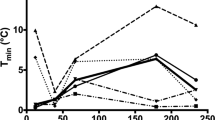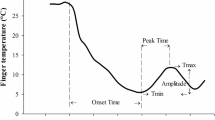Abstract
Purpose
Cold-induced vasodilatation (CIVD) is a peripheral blood flow response, observed in both the hands and feet. Exercise has been shown to enhance the response, specifically by increasing mean skin temperatures (Tsk), in part due to the increased number of CIVD waves. In contrast, hypobaric hypoxia has been suggested to impair digit skin temperature responses, particularly during subsequent hand rewarming following the cold stimulus. This study examined the combined effect of exercise and hypobaric hypoxia on the CIVD response. We compared the CIVD responses in the digits of both the hands and feet of a team of alpinists (N = 5) before and after a 35-day Himalayan expedition to Broadpeak, Pakistan (8051 m).
Methods
Five elite alpinists participated in hand and foot cold water immersion tests 20 days before and immediately upon return from their expedition.
Results
The alpinists summited successfully without supplemental oxygen. Post-expedition, all alpinists demonstrated higher minimum Tsk in their hands (pre: 9.9 ± 1.1, post: 10.1 ± 0.7 °C, p = 0.031). Four alpinists had either greater CIVD waves, and, consequently, higher mean Tsk in their hands, or higher recovery temperatures (pre: 26.0 ± 5.5 °C post: 31.0 ± 4.1 °C, p = 0.052), or faster rewarming rate (pre: 2.6 ± 0.5 °C min−1 post: 3.1 ± 0.4 °C min−1,p = 0.052). In the feet, the responses varied: 1/5 had higher wave amplitudes and 1/5 had higher passive recovery temperatures, whereas 3/5 had lower mean toe temperatures during cold exposure.
Conclusions
The results of the cold stress test suggest after a 35-day Himalayan expedition, alpinists experienced a slight cold adaptation of the hands, but not the feet.




Similar content being viewed by others
Abbreviations
- ANOVA:
-
Analysis of variance
- CIVD:
-
Cold-induced vasodilatation
- AUC:
-
Area under the curve
- T sk :
-
Skin temperature
References
Amon M, Keramidas ME, Kounalakis SN, Mekjavic IB (2012) The effect of a sleep high-train low regimen on the finger cold-induced vasodilation response. High Alt Med Biol 13:32–39
Brändström H, Grip H, Hallberg P, Grönlund C, Angquist KA, Giesbrecht GG (1960) Hand cold recovery responses before and after 15 months of military training in a cold climate. Aviat Space Environ Med 79:904–908
Brown GM, Page J (1952) The effect of chronic exposure to cold on temperature and blood flow of the hand. J Appl Physiol 5:221–227
Chen F (1997) Thermal responses of the hand to convective and contact cold—with and without gloves. Dissertation. National Institute of Working Life, Solna
Cheung SS, Daanen HA (2012) Dynamic adaptation of the peripheral circulation to cold exposure. Microcirculation 19:65–77
Cheung SS, Mekjavic IB (2007) Cold-induced vasodilatation is not homogenous or generalizable across the hand and feet. Eur J Appl Physiol 99:701–705
Daanen HA, Ducharme MB (1999) Finger cold-induced vasodilation during mild hypothermia, hyperthermia and the thermoneutrality. Aviat Space Environ Med 70:1206–1210
Daanen HA, van Ruiten HJ (2000) Cold-induced peripheral vasodilation at high altitudes—a field study. High Alt Med Biol 1:323–329
Daanen HA, van der Struijs NR (2005) Resistance Index of Frostbite as a predictor of cold injury in arctic operations. Aviat Space Environ Med 76:1119–1122
Daanen HA, Koedam J, Cheung SS (2012) Trainability of cold induced vasodilatation in fingers and toes. Eur J Appl Physiol 112:2595–2601
Debevec T, McDonnell AC, Macdonald IA, Eiken O, Mekjavic IB (2014) Whole body and regional body composition changes following 10-day hypoxic confinement and unloading-inactivity. Appl Physiol Nutr Metab 39:386–395
Dobnikar U, Kounalakis SN, Mekjavic IB (2009) The effect of exercise-induced elevation in core temperature on cold-induced vasodilatation response in toes. Eur J Appl Physiol 106:457–464
Felicijan A, Golja P, Milcinski M, Cheung SS, Mekjavic IB (2008) Enhancement of cold-induced vasodilatation following acclimatization to altitude. Eur J Appl Physiol 104:201–206
Flouris AD, Cheung SS (2010) On the origins of cold-induced vasodilation. Eur J Appl Physiol 108:1281–1282
Gorjanc J, Morrison SA, Blagus R, Mekjavic IB. (2017) Cold susceptibility of digit stumps resulting from amputation after freezing cold injury in elite alpinists. High Alt Med Biol. https://doi.org/10.1089/ham.2017.0134 (Epub ahead of print, in press)
Keramidas ME, Musizza B, Kounalakis SN, Mekjavic IB (2010) Enhancement of the finger cold-induced vasodilation response with exercise training. Eur J Appl Physiol 109:133–140
Keramidas ME, Kölegård R, Mekjavic IB, Eiken O (2015) Hand temperature responses to local cooling after a 10-day confinement to normobaric hypoxia with and without exercise. Scand J Med Sci Sports 25:650–660
Kounalakis SN, Keramidas ME, Amon M, Eiken O, Mekjavic IB (2017) A 10-day confinement to normobaric hypoxia impairs toe, but not finger temperature response during local cold stress. J Therm Biol 64:109–115
Launay JC, Sauvourey G (2009) Cold adaptations. Ind Health 47:221–227
Leblanc J, Hildes JA, Heroux O (1960) Tolerance of Gaspe fishermen to cold water. J Appl Physiol 15:1031–1034
Mathew L, Purkayastha SS, Selvamurthy W, Malhotra MS (1977) Cold-induced vasodilatation and peripheral blood flow under local cold stress in man at altitude. Aviat Space Environ Med 48:497–500
Meehan JP (1955) Body heat production and surface temperature in response to a cold stimulus. J Appl Physiol 7:537–541
Mekjavic IB, Dobnikar U, Kounalakis SN, Musizza B, Cheung SS (2008) The trainability and contralateral response of cold-induced vasodilatation in the fingers following repeated cold exposure. Eur J Appl Physiol 104:193–199
Mekjavic IB, Dobnikar U, Kounalakis SN (2013) Cold-induced vasodilatation response in the fingers at 4 different water temperatures. Appl Physiol Nutr Metab 38:14–20
Morrison SA, Gorjanc J, Mekjavic IB (2014) Mount Everest and Makalu cold injury amputation: 40 years on. High Alt Med Biol 15:78–83
Morrison SA, Gorjanc J, Eiken O, Mekjavic IB (2015) Finger and toe temperature responses to cold after freezing cold injury in elite alpinists. Wilderness Environ Med 26:295–304
Nelms JD, Soper DJ (1962) Cold vasodilatation and cold acclimatization in the hands of British fish filleters. J Appl Physiol 17:444–448
O’Brien C (2005) Reproducibility of the cold-induced vasodilation response in the human finger. J Appl Physiol 98:1334–1340
Payne S, Macintosh A, Stock J (2018) Body size and body composition effects on heat loss from the hands during severe cold exposure. Am J Phys Anthropol. https://doi.org/10.1002/ajpa.23432
Quindry J, Dumke C, Slivka D, Ruby B (2016) Impact of extreme exercise at high altitude on oxidative stress in humans J Physiol 594:5093–5104
Savourey G, Vallerand AL, Bittel JHM (1992) General and local cold adaptation after a ski journey in a severe arctic environment. Eur J Appl Physiol 64:99–105
Sutton JR, Reeves JT, Groves BM, Wagner PD, Alexander JK, Hultgren HN, Cymerman A, Houston CS (1992) Oxygen transport and cardiovascular function at extreme altitude: lessons from Operation Everest II. Int J Sports Med 13:13–28
West JB (1993) Acclimatisation and tolerance to extreme altitude. J Wilderness Med 4:17–26
Yoshimura H, Iida T (1952) Studies on the reactivity of skin vessels to extreme cold II. Factors governing the individual difference of the reactivity, or the resistance against frostbite. Jpn J Physiol 2:177–185
Acknowledgements
The authors express their gratitude to the dedicated alpinists who altruistically took part in this study.
Funding
No external funding was used for this research.
Author information
Authors and Affiliations
Contributions
JG, SAM, ACM, and IBM contributed to the conception and design of the work; JG, SAM, and ACM contributed to data acquisition; JG, SAM, ACM, and IBM contributed to the analysis and interpretation of the work; JG and SAM drafted the manuscript; JG, SAM, ACM, and IBM revised it critically, and approved the final submitted version.
Corresponding author
Ethics declarations
Conflict of interest
No conflict of interest is declared.
Additional information
Communicated by George Havenith.
Rights and permissions
About this article
Cite this article
Gorjanc, J., Morrison, S.A., McDonnell, A.C. et al. Koroška 8000 Himalayan expedition: digit responses to cold stress following ascent to Broadpeak (Pakistan, 8051 m). Eur J Appl Physiol 118, 1589–1597 (2018). https://doi.org/10.1007/s00421-018-3890-3
Received:
Accepted:
Published:
Issue Date:
DOI: https://doi.org/10.1007/s00421-018-3890-3




